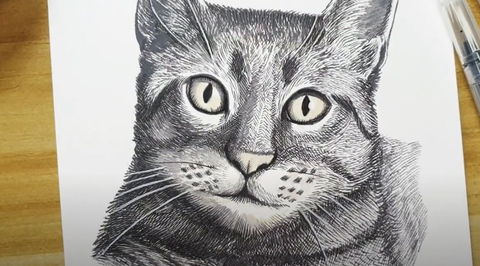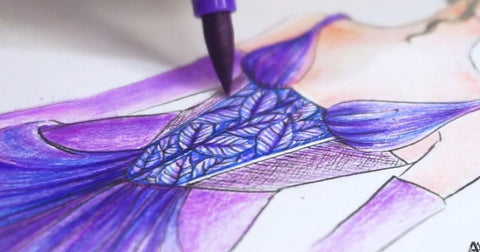Into the Creative Mind of Mary Cassatt: Her Art, Style, and Story
Last Updated: July 29, 2024
Mary Cassatt's significance in modern art cannot be overstated. As an American artist living in Paris during a time of artistic revolution, she played a crucial role in shaping the Impressionist movement. Her paintings, characterized by their soft brushwork and luminous colors, offered a fresh perspective on everyday life. Cassatt's ability to infuse her work with emotion and sensitivity set her apart from her contemporaries and solidified her place in art history.

Baby’s First Caress by Mary Cassatt (1891)
Her unique artistic style, influenced by Impressionism and Japanese aesthetics, captured the intimate moments of women and children in domestic settings. In this blog post, we will delve into the creative mind of Mary Cassatt, exploring her art, style, and story.
Who is Mary Cassatt?
Art has the power to transport us to different worlds, evoke deep emotions, and challenge our perspectives. One artist who achieved all of this and more is Mary Cassatt. Born in 1844 in Pennsylvania, Cassatt was a pioneering figure in the Impressionist movement and a trailblazer for female artists in a male-dominated field.

A portrait of a young Mary Cassatt
Understanding an artist's perspective and creative process is essential to fully appreciate their work. In the case of Mary Cassatt, her personal experiences greatly influenced her art. After moving to Paris to study art, she became acquainted with the Impressionist circle, including Edgar Degas, who became a close friend and mentor. Cassatt's exposure to Japanese woodblock prints also left a lasting impression on her artistic style, leading her to incorporate elements of Japanese art and aesthetics into her own work. By gaining insight into Cassatt's influences and motivations, we can develop a deeper appreciation for the beauty and complexity of her art.
Mary Cassatt's Artistic Style and Influences
Cassatt's artistic style was heavily influenced by the Impressionist movement, which sought to capture the fleeting effects of light and color in everyday scenes. She embraced the use of loose brushwork and unblended colors, creating a sense of spontaneity and movement in her paintings. Cassatt's keen observation of light and shadow allowed her to convey depth and atmosphere with remarkable skill.
In addition to Impressionist influences, Cassatt was drawn to Japanese art and aesthetics, particularly the use of flattened space, asymmetrical compositions, and emphasis on decorative patterns. She integrated these elements into her own work, resulting in a unique fusion of Western and Eastern artistic traditions. This cross-cultural exchange not only set her apart from her peers but also contributed to the development of a new visual language in Western art.

Portrait of Mrs. Havemeyer and Her Daughter Electra by Mary Cassatt (1895)
A recurring theme in Cassatt's work is the portrayal of women and domestic scenes. She depicted women engaged in everyday activities such as reading, sewing, and caring for children, offering an intimate glimpse into their lives. Through her art, Cassatt challenged traditional notions of femininity and motherhood, presenting women as complex individuals with their own thoughts and emotions.
5 Famous Paintings by Mary Cassatt

1. Little Girl in a Blue Armchair
In "Little Girl in a Blue Armchair," Cassatt captures a tender moment as a young girl sits in a blue armchair, lost in thought. The painting exudes a sense of tranquility and innocence, with the girl's wistful expression drawing the viewer into her world. The composition is carefully balanced, with the girl's figure positioned off-center to create visual interest. Cassatt's use of light and color imbues the scene with a soft, ethereal quality, emphasizing the girl's delicate features.

2. An American in Paris
"An American in Paris" reflects Cassatt's perspective as an outsider navigating the bustling city life of Paris. The painting depicts a woman seated at a café table, surrounded by fashionable Parisians. Through her portrayal of modern urban life, Cassatt captures the vibrancy and energy of the city while also conveying a sense of detachment experienced by the American woman. The juxtaposition of light and shadow adds depth to the composition, drawing attention to the figures within the scene.

3. In the Loge
"In the Loge" offers a glimpse into the world of theater and spectatorship as a woman gazes out from her box seat. Cassatt's exploration of female spectatorship is evident in the woman's poised posture and attentive expression. The use of perspective and framing draws the viewer's eye toward the central figure, creating a sense of intimacy within a public setting. Cassatt masterfully conveys the interplay between performance and audience, highlighting the complex dynamics at play.

4. The Tea
Cassatt's portrayal of domestic life and female relationships takes center stage in "The Tea." The painting depicts two women engaged in conversation during a tea gathering, their gestures and expressions conveying a sense of familiarity and warmth. Cassatt's attention to detail is evident in the delicate rendering of fabrics and textures, as well as the play of light across the scene. The overall atmosphere exudes a sense of comfort and camaraderie, inviting the viewer to share in the quiet intimacy of the moment.

5. Emmie and Her Child
"Emmie and Her Child" showcases Cassatt's tender depiction of motherhood and the bond between mother and child. The painting captures a private moment between a mother and her child, their close physical proximity emphasizing the emotional connection between them. Cassatt's sensitive handling of light and shadow adds depth to the composition, while her expressive brushwork conveys the intimacy of the scene. The work evokes a universal sense of love and nurturing that transcends time and place.
Mary Cassatt's Influence on Modern Art
Cassatt's contributions to the Impressionist movement were significant in shaping the course of modern art. Her innovative approach to capturing light and color paved the way for future generations of artists to explore new modes of expression. As one of the few female artists associated with the Impressionists, Cassatt broke barriers and challenged societal norms regarding women in the arts. Her pioneering role continues to inspire contemporary artists to push boundaries and defy expectations.
In addition to her artistic legacy, Cassatt's impact on contemporary and future generations of artists cannot be overstated. Her ability to infuse everyday scenes with depth and emotion serves as a timeless source of inspiration for artists across disciplines. By portraying women as multifaceted individuals with agency and autonomy, Cassatt's work remains relevant in ongoing conversations about gender equality and representation in art.

Mary Cassatt's art, style, and story offer a window into a world of beauty, emotion, and innovation. Through her unique blend of Impressionist techniques and Japanese influences, she created a body of work that continues to captivate audiences around the world.
By understanding Cassatt's perspective and creative process, we gain insight into the complexities of human experience as portrayed through art. As we reflect on her artistic legacy, let us embrace the opportunity to explore and appreciate the enduring impact of Mary Cassatt's remarkable contributions to modern art. Read more Famous Artists and Their Work here.






